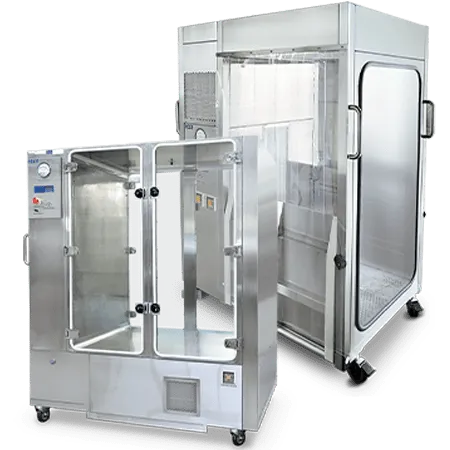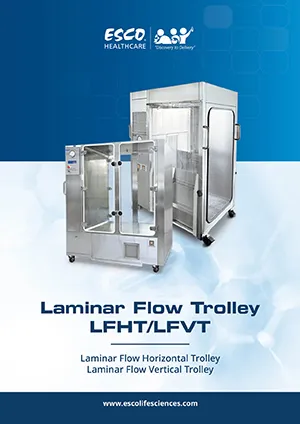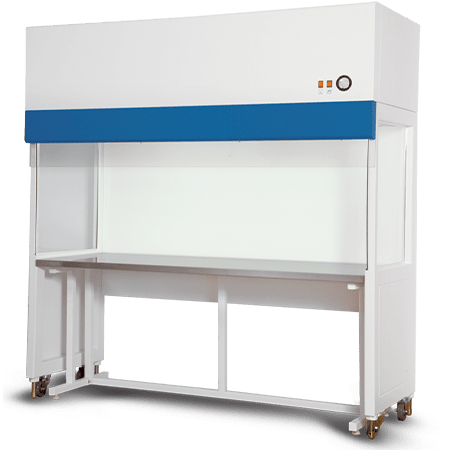Laminar Flow Horizontal Trolley / Laminar Flow Vertical Trolley (LFHT/LFVT)
Laminar Flow Horizontal or Vertical Trolleys are mobile transport carts or trolleys providing ISO Class 5 clean air (as per ISO 14644-1). These laminar flow trolleys utilize a unidirectional airflow to eliminate contamination during the transfer of sterile/aseptic materials.
Laminar Trolleys are customizable units that can provide:
Product aseptic zones with single pass or recirculatory airflow.
Operator or environment protection (only available in recirculatory airflow) and in negative pressure with respect to ambient.
Stand alone units mounted over mobile stands for mobile aseptic zones.
Applications
Medical Industry (i.e., operating theatre)
Filling Line System ISO Class 5 coverage
Nanotechnology
High-End Electronics
Space Industry
Pharmaceutical Industry
Research and Development Laboratories
Easy-to-clean design
Welded stainless steel construction (optional: powder coated EG steel) for easy cleaning
Internal chamber visibility
10 mm tempered glass doors with plastic latches
Durable hinges
Corrosion-resistant stainless steel hinges
HEPA or ULPA filtration
HEPA/ULPA knife edge gel-sealed design better than conventional gasket sealed
Guaranteed smooth mobility
Great load-bearing capacity Polyurethane (PU) wheels
Audiovisual alarms provision
Sentinel™ Gold microprocessor controller with audio/visual alarms for downflow velocity
Fully functional stand-alone unit
UPS Battery for onboard power when not connected to main building supply
Emergency safety control
Emergency stop button
The Esco Laminar Flow Horizontal/ Vertical Trolley functions by drawing in ambient air from the room, and passing it via a G4 prefilter before it enters the perforated diffuser into the supply plenum. This airflow passes through a baffle system prior to gel seal HEPA filtration, creating a low decibel aseptic zone for operator comfort.
In a single pass airflow type, a hundred percent (100%) of the potentially contaminated air which passes through the aseptic zone will be exhausted out of the trolley.
While in a recirculatory airflow type, the potentially contaminated air will be recirculated back for HEPA filtration before being supplied back to the aseptic zone.
|
Guide to Models |
|||||||
|
CLAF-PC-1-AC-H14 |
|||||||
|
Product Code |
MOC |
Internal Width |
Internal Dimension |
Internal Height |
Airflow Pattern |
Airflow Pressure |
Battery Life (Hrs) |
|
V- Vertical airflow |
A-EG Steel Exterior/Interior with SS304 base. |
TBD* |
TBD* |
TBD* |
S-Single Pass R-Recirculatory |
P-Positive N-Negative |
A half hour (standard) |
|
H- Horizontal airflow |
B-SS Full SS304 right angle
corners. |
TBD* |
TBD* |
TBD* |
|||
*TBD – To be discussed according to the customer’s
preference.
OPTIONAL CONFIGURATIONS
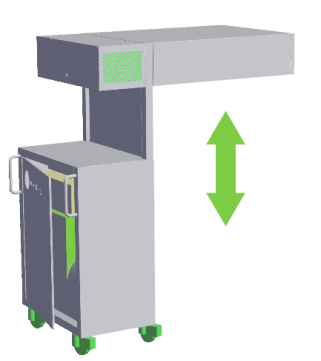
Hydraulic height adjustable
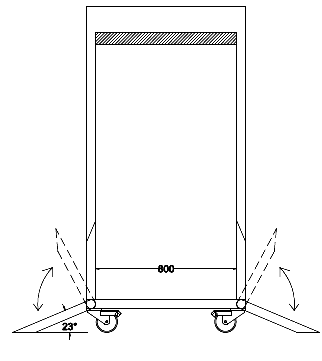
Hydraulic Ramp
Hydraulic adjustable stands
Electromagnetic interlocking doors
Perforated shelves
Splashproof electrical outlets
PVC strips Curtains
Pressure gauge provision
Selection of material of construction between an electrogalvanized (EG) steel exterior with ISOCIDE™ antimicrobial powder coating or full SS304 exterior and interior.
AIRFLOW PATTERNS
Single Pass
Recirculatory
What is the difference of a laminar flow vertical trolley (LFVT) from a horizontal (LFHT) one?
Filtered air supply in laminar flow vertical trolley comes from the top portion of the unit while, in a horizontal flow trolley it is supplied from the side. Laminar flow vertical trolleys are usually suitable for large equipment transfer (to prevent airflow blockage) while laminar flow horizontal trolleys are usually used for small material transfer such as vials.
What are the common applications of laminar flow trolleys?
- Temporary storage of critical materials or products
- Transport in facility requiring aseptic work zones
- Transport of materials from cleanroom to a cleanroom, through a non-cleanroom area
- Transport of bulk drug products
- Transport of process skids or feed hoppers
- Transport of autoclaved substances
- Transport of lyophilized vials to and from freeze dryers
- Transport of Grade A to Grade A products
- Transport of materials within cGMP facilities
- also applicable for institutions unable to upgrade their cleanroom facilities to comply to cGMP standards; and
- upgrading facilities from clinical to commercial sites while preventing production losses due to long turnover when building new cGMP sites.
What is the standard UPS battery life (Hrs) supplied?
The standard battery life supplied is a half hour. Depending on the requirement, this is also possible to customize.
Which configuration is best suitable for aseptic processing?
When handling non-hazardous sterile/aseptic products/ materials, the laminar flow trolley can be equipped with either single pass or recirculatory airflow. The internal chamber is also maintained in a positive pressure with respect to the external environment to allow protection for the critical items loaded within the unit.
Which configuration is best for operator and environmental protection?
When dealing with non-volatile hazardous substances, the unit is equipped with a recirculating airflow. Furthermore, it is also maintained in a negative pressure with respect to its surrounding environment to provide containment, and to prevent the potentially contaminated air from leaking out from the unit.
What are the advantages of using Laminar Flow Trolleys?
Utilizing LFHT/LFVT can help enhance cGMP compliance, since these units can be constructed with stainless steel construction hence are designed to be easy to clean. In addition, these units provide transfer in cGMP facilities from differing unit operations to reduce cross contamination risks. They are also applicable for institutions unable to upgrade their cleanroom facilities to comply to cGMP standards.

